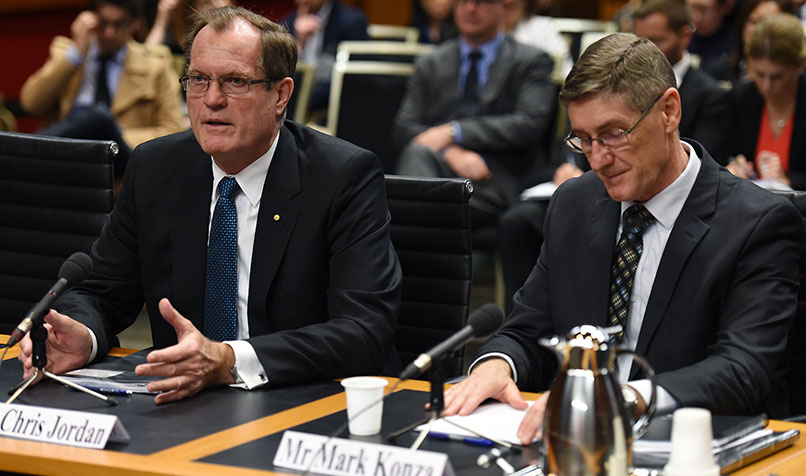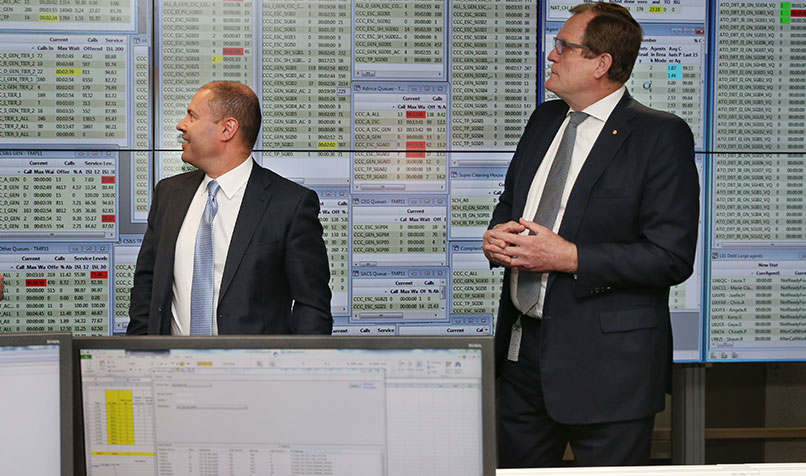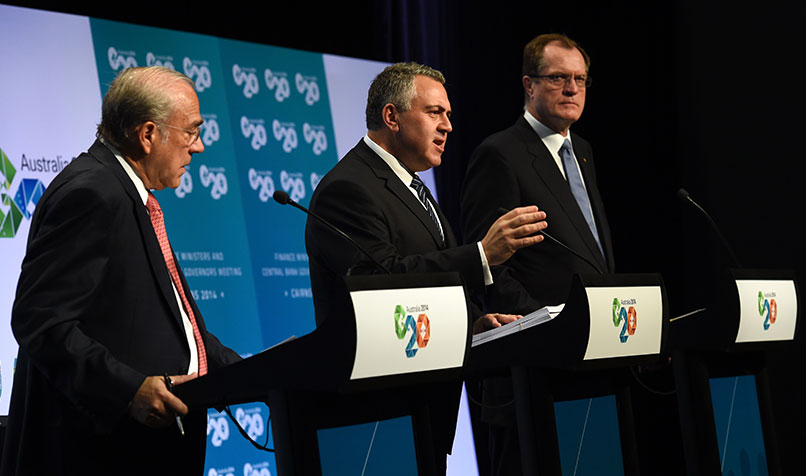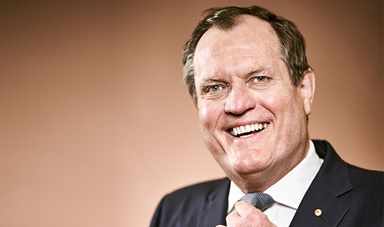Loading component...
At a glance
- Early in his tenure, Australian tax commissioner Chris Jordan targeted large corporate tax payers. He has recently turned his focus to individuals and SMEs.
- ATO estimates reveal a gap of 12.5 per cent or A$11.1 billion in SME tax in 2015-2016. This is the highest dollar figure and the highest percentage figure of any Australian tax gap number.
- Jordan says building trust in the ATO is one of the fundamental tenets of his work.
By David Walker
Australia’s tax commissioner, Chris Jordan, has a plan – the same plan he’s had since early in his tenure, which began in January 2013.
Step one was to target large corporates. Step two was to present compelling evidence that they’re no longer the biggest source of revenue loss. Step three is to widen his net and start pulling in more tax offenders across society.
In an interview with INTHEBLACK, Jordan has set out how he hopes the plan will play out over his remaining years in the job.
At the top of his concerns is mistrust of the ATO. No matter what the organisation does, he fears “people still say: ‘you’re only coming after the small businesses, you’re only coming after work-related expenses because we’re defenceless’.”
He needs taxpayers to trust that he’s doing more than that.

Now, Jordan has turned the ATO’s attention to what are, in dollar terms, the bigger targets: small businesses and individuals.
This has risks. Big corporations have excellent lawyers, but extracting tax revenue from them has few risks in an era where even a Coalition government trumpets a crackdown on banks.
Economist Saul Eslake, a veteran observer of the interactions between Australia’s economic and political worlds, puts it bluntly: “It’s politically easier to go after big companies than small ones”.
In the search for trust, Jordan has turned to the set of estimates collectively known as the “tax gaps”.
The tax gaps began as an exercise by US and then UK tax authorities to find the difference between what they were bringing in for a particular tax, and what they’d reap if every taxpayer paid all that they owed. The ATO under Jordan has taken up the idea and applied it to a dozen taxes and taxpayer groups.
“We have a more comprehensive suite of measurements of tax gaps than, I think, any other country,” Jordan says.
University of New South Wales tax administration expert Professor Neil Warren agrees, saying that “in terms of breadth and refinement, they’re now leading-edge”.
The tax gap estimates are necessarily imperfect. Even to the extent they’re accurate, they’re not just measuring cheating; much of any tax gap may be legitimate error.
Regardless, for those convinced that tougher corporate tax is the answer to all Australia’s revenue woes, the gap numbers are sobering news. The ATO estimates the net income tax gap for large corporates was 4.4 per cent in 2015-2016, or A$1.8 billion of all tax owed. That number has been falling in recent years, the ATO says; it’s now at its lowest level on record.
"We have more comprehensive suite of measurements of tax gaps than, I think, any other country."
The published numbers for small businesses and individuals, on the other hand, are much bigger than the numbers for large corporates.
The gap for what the ATO calls “individuals not in business” is 6.4 per cent or A$8.7 billion for 2014-2015. Much of the gap relates to deductions.
“When you get A$21 billion claimed as work-related expenses, that’s a big pot of money,” Jordan notes, “so there’s got to be a little bit of playing around.”
On the ATO’s estimate, there’s even more to be recovered from small business taxes, where the gap is a hefty 12.5 per cent or A$11.1 billion for 2015-2016. It’s a steep number by international standards, Jordan says. At the same time, he notes, it’s both the highest dollar figure and the highest percentage figure of any Australian tax gap number. “We can’t ignore that.”
Jordan knows that statistics and reasoning will not shield him from all criticism while he demands greater tax compliance from small businesses and individuals. Nevertheless, the tax gap numbers are giving him some protection as the ATO takes aim at sensitive targets like work-related deductions and rental income. Early results show the individual tax gap is shrinking.
Tax as sport

The tax gap figures are also designed to play a part in shifting Australia’s tax culture. Australians sometimes describe cheating on tax as “a bit of a sport”, he says. He tells of a social event where he heard another guest brag of a cash deal.
“Someone was telling me at a barbecue the other day: ‘One guy quoted me for seven and a half thousand. Another guy, he said he’d do it for six, for cash. Of course, I took the six’,” Jordan recounts.
“I’m not sure that they knew what I did. They were proudly saying, ‘I saved this amount of money’. But you wouldn’t hear people standing around a barbecue saying, ‘Hey, I’m registered three times for unemployment benefits ... Aren’t I great!’ You would never get that.”
Doing the right tax thing
The push to shrink the tax gaps of small businesses and individuals has the potential to bring the ATO into greater conflict with tax agents. This relationship, dogged early on by concerns about the ATO’s tax portal, has never been easy for Jordan.
He volunteers that “most agents do the right thing”. He says figures in areas such as rental income – where an audit found errors in almost nine out of 10 returns reviewed – came as “a revelation” to the profession, as well as to the ATO. He describes the results on rental income and work-related expenses as “very sensitive”, and says the ATO spent a lot of time pondering how it went about publicising them.
"I don't know if I did a good job or not... I didn't want to upset tax agents and the good CPAs who are out there doing the right thing."
“I don’t know if I did a good job or not, but I didn’t want to upset accountants,” he explains. “I didn’t want to upset tax agents and the good CPAs who are out there doing the right thing.”
However, he also says the ATO will hit tax advisers “harder where it’s required”, looking at an individual adviser’s history to determine when tough treatment is warranted. He wants more empathy for taxpayers and advisers who warrant it. For those who use over-aggressive tactics, he says he is advising staff: “Don’t play with these people”.
Defending the institution of tax

In an era of institutional mistrust, Jordan knows he must keep making the case for the ATO's current course if this plan is to succeed.
Challenges have emerged along the way. A joint Four Corners-Nine newspaper report in April last year included allegations that the ATO had ordered a “cash grab on small business” in its Adelaide office.
A review by the Inspector-General of Taxation cleared the ATO of the cash grab claims, but suggested a need for better staff training.
“We’ve actually spent a disproportionate amount of our time and effort and investment on this whole business sector,” Jordan says.
He has also had to defend Australia’s system of corporate tax after an ABC website article, published in February last year, claimed one in five of Australia’s top companies don’t pay it.
While wary of criticising the media, Jordan now worries it has helped erode people’s confidence, which he says is not good for the ATO “because we want people to have confidence in us. We want people to trust us.”
Chris Jordan is approaching the end of his seventh year at the head of the ATO. He admits, reluctantly, to being 65 years old. His current term – his second, ending in 2024 – will be his last. He has spent his tenure trying to build the trust the ATO needs, step by step. Trust is, he says, “one of the fundamental tenets” of his whole program.
With the publication of the tax gaps, Jordan says, “I think the community is starting to understand” the need to claw back more tax from across the community.
By 2024, he is likely to find out whether he’s right.
Jordan's path to the ATO
Chris Jordan is the 12th commissioner of taxation, appointed on 1 January 2013; his term runs until 29 February 2024.
Jordan’s 35 years of experience in the tax profession include expertise in tax policy and law development and its implementation. He held private and public sector roles, as adviser to Labor and Coalition governments.
Jordan’s career in the profession began in 1979, when he joined accounting firm Arthur Andersen, followed by a few years at the University of Technology Sydney, where he worked as a senior lecturer in taxation. He proceeded to work at KPMG for more than two decades: he served as partner in charge of KPMG’s New South Wales tax and legal division from 1995 to 2000, and then as chairman of partners for KPMG New South Wales from 2001 to 2012.
He served as chairman of the new tax system advisory board from 1999 to 2001. He has been a member of the Board of Taxation since its inception in 2000, serving as chairman from June 2011 to December 2012. He was also chairman of the Business Tax Working Group during this time, and a member of the group that consulted with the mining industry about the resource rent tax.
Jordan has a master of law (University of Sydney) and a bachelor of commerce and law (University of New South Wales). He is a fellow of the Australian Institute of Chartered Accountants and a chartered tax adviser with the Tax Institute.
Killing the great Aussie tax deduction?

Jordan has talked frequently over the past six years about the potential for technology to make tax easier for people and more efficient for the tax office. In one version of this future, individuals and small businesses would use tax software linked directly to the ATO, and have their returns completely populated from their accounts.
Such a change could hold the potential to cut tax agents right out of the process. New Zealand has redesigned its system, Jordan points out, and “about 60 per cent” of New Zealanders do what the ATO calls a “push income tax assessment”.
ATO Second Commissioner Andrew Mills said earlier this year that the ATO wanted to have a push assessment too by 2024 – a system where, for individuals, “tax just happens”. In such a world, Jordan says, “a lot of agents ... wouldn’t really have a viable business”.
As he explains, Australia can’t opt for such dramatic change at the moment because the system of work-related expenses deductions, in particular, requires too much taxpayer intervention. That seems unlikely to change for a little while.
Although Jordan and his team have had discussions with Treasury and “they’re aware of what the New Zealand model is”, Australia’s political leaders have little enthusiasm for killing the great Aussie tax deduction. As Professor Warren puts it, “Australia has a strong culture of the tax refund”.
Yet the ATO also has huge new streams of data starting to flow in from sources such as the new Single Touch Payroll system and, internationally, the base erosion and profit shifting (BEPS) system.
Jordan names the use of such data as the ATO’s single biggest new challenge. Therefore, instead of a big-bang change, he now envisages a string of incremental automations. In the 2018 financial year, he notes, 60,000 Australian taxpayers did get a “push return” because they lodged a return only to get franking credits refunded. With extra data, more groups can follow.
He elaborates: “My argument here is, let’s not get caught up on the notion of a push return being total. We’ve got myTax now; that has all the income side done – all your details, all your partner’s details, all your medical details and so on, all done.”
It may not be a push return, but enough fields are pre-filled that it’s “getting pretty close”, he says. “You’ve got the whole form filled there, with all the addresses, all the numbers ... all the incomes are covered. Any deductions, whack ’em in and press [send].”
More fields will be pre-filled over time. For instance, the ATO is currently linking its systems to those of state land title offices.

